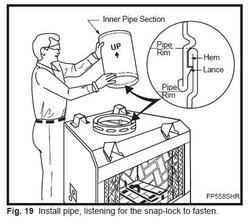OK, i have an issue with my chimney flue. Its a double wall as far as i know. I did not install it or have it installed, it was already there when we moved in, and has never had a fire in it. It seems when it rains moderately, i get water running down the outside (and inside) of the flue. It doesnt pour in, but its a fair amount i think. I have attached some pics of my setup and where it leaks. The sealant on top is good, though it looks cracked. Whats wrong with this thing?
Thanks for your help!



Thanks for your help!



